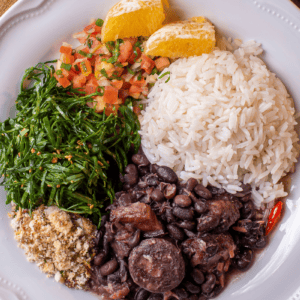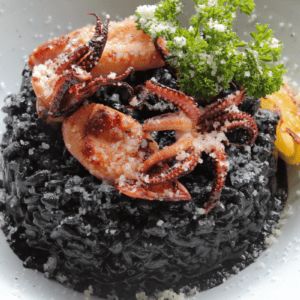Greek Rice Pilaf (Arroz a Grega)

Arroz a Grega, or “Greek rice pilaf,” is a popular side dish in Brazil, especially at Christmas time. Despite the name, it is not, necessarily, Greek. There are disputes as to the origin of the dish and its name. Regardless, the general recipe incorporates traditional methods for cooking pilaf-style rice, while incorporating a few quintessentially Brazilian ingredients.
Table of Contents
What is Rice Pilaf?
Pilaf, in general, refers to a style of cooking long-grain rice. It usually involves toasting the rice in oil with aromatics, like onions and garlic, then simmering the rice in a flavorful broth with various proteins (lamb, chicken, fish, etc.) The result is a hearty dish with rice granules that are individual, not sticky like jasmine rice or creamy like risotto.
Where Does Rice Pilaf Come From?
Although rice had already been in cultivation for thousands of years, the earliest recipes for rice pilaf were written in the 10th century. The famed Persian philosopher and physician, Ibn Sina, included various recipes in his medical texts, describing the benefits of different ingredients. In Iran, he is still referred to as the “Father of Pilaf.”
This does not mean that pilaf did not exist in some iteration prior to this date. There are accounts, for example, of soldiers in Alexander the Great’s army (4th century BC3) eating “pilav,” and bringing the recipes home from Central Asia to Macedonia.
The name itself has two derivatives. “Pilaf” is used predominantly in North America. It is derived from the Turkish pilav, which comes from the earlier Persian pilāv. British and Commonwealth nations refer to the dish as pilau, also Persian in origin and possibly Urdu, where the word pulāv indicates a dish of rice and meat cooked together.
While the exact roots of the dish remain a mystery, it seems we can assume (based on the name and documentation) that the first pilafs came from the Middle East and surrounding regions. As trade routes expanded and cultural exchange flourished, rice pilaf made its way to various corners of the world, where it adapted to local ingredients and cooking techniques.
Global Variations of Rice Pilaf
Caribbean Pelau: Eastern Caribbean recipes call for various local ingredients, like peas, pumpkin, and corn, along with pieces of chicken or cured pig’s tail. Other parts of the Caribbean add coconut milk and seafood, like crab meat.
South Asian Biryani: this dish originated with the Muslims of South Asia. It combines basmati rice with marinated meat (usually chicken, lamb, or shrimp) and a blend of aromatic spices, creating a rich and savory dish. Vegetarian versions with vegetables or paneer are also popular. In India, a dish called “pulao” also exists, but it is made with lentils and vegetables. Bengali pulao is more traditional, with saffron and long-grain rice.
Central Asian Plov: In countries like Uzbekistan and Tajikistan, plov (or pilaf) is a staple dish made with long-grain rice, lamb or beef, garlic, and onion. It is usually seasoned simply with salt, pepper, and cumin, although other herbs and spices may be added regionally.
Lithuanian Plovas: in addition to rice and vegetables (usually carrots, tomatoes, and/or mushrooms), plovas may contain chicken or pieces of pork derived from around the neck or stomach of the animal.
Arroz Grega in Brazil
In Brazil, rice pilaf is a staple item on the Christmas dinner table. The Brazilian version of rice pilaf, known as “arroz à grega,” showcases the country’s diverse culinary influences.
“Arroz à grega” translates to “Greek-style rice,” but it reflects a fusion of international flavors. This dish typically features white rice cooked with a medley of colorful vegetables like bell peppers, peas, and carrots. It’s often seasoned with olive oil and sometimes enhanced with raisins and cashew nuts for a touch of sweetness and crunch.
The vibrant colors and flavors of “arroz à grega” make it a festive addition to the Brazilian Christmas feast, providing a harmonious balance to the ubiquitous Chester hen and hearty stews that often take center stage during the holiday season.
Why is It Called Greek Rice in Brazil?
No one really knows. While the Greeks do have their own version of pilaf rice, it is not, technically, a Greek dish. Furthermore, the Greek rice pilaf in Brazil incorporates ingredients not commonly found in Greek and other Baltic versions-namely, carrots and bell peppers. Either way, the name “arroz a Grega” has stuck, and indicates a specific Brazilian side dish simmered in broth with vegetables and raisins.
Best Rice for Brazilian Greek Pilaf
Like traditional Brazilian rice, arroz a grega uses long-grain rice. This is important: long-grain rice has less starch, which keeps the granules from sticking to each other. You can use short-grain rice if that is what you have, but it will be harder to achieve the desired pilaf texture.
Arroz Grega Recipe (Brazilian Rice Pilaf)
Ingredients:
2 cups long grain rice, such as Basmati
1 tbsp extra virgin olive oil
1 oz unsalted butter
1 yellow onion, finely diced
1 red bell pepper, diced
1 yellow bell pepper, diced
1 cup sweet green peas (fresh or frozen)
2 cloves garlic, minced
1 carrot, peeled chopped
¼ cup golden raisins
1 tsp red chili flakes
1 tsp ground cumin
3 cups chicken stock
2 tsp salt (more to taste)
Freshly ground black pepper
Diced spring onions for garnish (optional)
Directions:
- Rinse the rice until the water runs clear, then set aside.
- Heat a large skillet or pot over medium. Add in a drizzle of olive oil and the butter, then sautee the bell peppers, onion, peas, and carrots for 3 minutes or so.
- Add in the minced garlic and cook for a further 30 seconds.
- Stir in the rinsed rice, and toast it in the oil and aromatics for 2-3 minutes.
- Season with salt, pepper, cumin and chili flakes.
- Add in the chicken stock and bring the rice mixture to a boil, then reduce the heat to a simmer.
- Cover, and cook for fifteen minutes, or until the liquid has been absorbed.
- Stir in the golden raisins and let them warm through. Taste for salt, and add more, if needed.
Serve piping hot alongside your favorite main course, like a delicious roast picanha or churrasco steak. Garnish with fresh spring onion slices.
Visit Texas de Brazil for Authentic Brazilian Food
Texas de Brazil is a dining experience like no other. From our mouthwatering, all you can eat churrasco meats, to our enormous salad bar, there is something for everyone to love at our restaurants. Now, you can experience the taste of Texas de Brazil at home with one of our premium butcher boxes: the highest quality cuts of beef, lamb, pork, and sausage delivered right to your door. Go online to order a la carte or a hand-curated box for your next cookout.




